Dundee City (Corporation) Tramways
History
The predecessor of Dundee Corporation, Dundee Police Commissioners, built the town's first tramway, which opened on the 30th August 1877. The standard-gauge system eventually grew to 5.66 miles, and was operated by a mix of horse and steam traction, though not by the Police Commissioners, but by a lessee, the Dundee and District Tramways Company. Following the passing of the Dundee Corporation Act of 1894, which received its Royal Assent on the 3rd July, Dundee became a County Borough, the Police Commissioners thereafter becoming Dundee Council. By 1897, the council's thoughts had begun to turn to electrification of its tramway system, opening negotiations with the company to acquire its tramway assets (tramcars, trailers, etc.), and importantly, to reach agreement for it to surrender its lease. The company's hand was, however, fairly strong, having another ten years of its lease to run, so it was able to extract a very favourable deal from the council, the latter agreeing to pay it £2,100 per annum for the remainder of the lease. The agreement, which was signed by Dundee Council on the 22nd November, and by the company on the 15th December 1897, set the date for the handover of the tramway as the 1st June 1899. With the agreement in the bag, the council sought powers to work the tramway, which were granted under the Dundee Corporation (Tramways) Act 1898, which received its Royal Assent on the 25th July 1898.
Meanwhile, the company continued to operate the tramway, but unsurprisingly, spent as little as it could get away with on maintenance etc., so that by the time the corporation (of which the council was the governing body) took over operation, the tramcars and track were in fairly run-down condition. By this time, however, plans to convert the existing tramway and to build extensions, were well in hand, further powers being granted under the Dundee Gas, Street Improvements and Tramways Act, 1899, which received its Royal Assent on the 13th July 1899. Contracts were issued the following month, with the first newly electrified line — along Perth Road — opening eleven months later on the 12th July 1900.
The conversion of the old tramway lines, and the construction of new ones — including further extensions authorised under the Dundee Corporation Act of 1901, which received its Royal Assent on the 26th July 1901 — was completed on the 20th November 1902 with the opening of the line along Constitution Road to Hilltown. Prior to this, the corporation had run its last horse-tram service, on the 13th June 1901, and its last steam-tram service, on the 14th May 1902.
The new electric services were operated by 54 tramcars, which unusually, mostly ran right through the city centre from one terminus to another.
In 1905, the corporation-owned system was connected to the newly built tracks of the Dundee, Broughty Ferry and District Tramways Company's line, which ran from Craigie Terrace eastwards, parallel to the Firth of Tay, to Monifieth. Unlike most corporations, Dundee encouraged construction of the company line, seeing it as a logical extension to its own system, and even agreeing to mutual through-running, which commenced on the day the new line opened on the 27th December 1905. Although the early services involved a change of crew at the municipal boundary, this inefficiency was soon eliminated, crews working right through from February 1906.
Investment in the corporation system continued throughout the mid-Edwardian era, including three further extensions (opened between 1906 and 1908), track doubling, new tramcars (taking the fleet to 60), and a programme that would result in the open-topped tramcars being top covered.
Although powers to operate trolleybuses were obtained in 1907, nothing was done for five years, when a short route along Clepington Road was opened on the 5th September 1912. The service was though, to prove unsuccessful, the poor state of the roads putting paid to the solid-tyred trolleybuses, which ran their final service on the 13th May 1914.
Meanwhile, further powers for tramway extensions were obtained under the Dundee Corporation (Improvements and Tramways) Act of 1913, which received its Royal Assent on the 4th July that year. This resulted in the opening of an extension from Balgay Lodge to Blackness on the 15th March 1914. That same year also saw an expansion of the Burgh, the corporation reaching agreement to purchase 1,514 yards of DBF&DTCo infrastructure (tracks and overhead) which lay within the expanded boundary. Apart from major track reorganisation in the city centre in 1933, this effectively brought the Dundee Corporation tramway system to its maximum size of circa 16.3 miles. From the High Street in the city centre, lines radiated westwards to Nine Wells and to Blackness; northwestwards to Lochee, northwards to Downfield (via Hilltown and via Victoria Bridge); northeastwards to Maryfield, with a branch to Baxter Park; eastwards to meet the tracks of the DBF&DTCo at Belsize Road (earlier Craigie Terrace); and southwards to Craig Pier. These lines were supplemented by a number of connecting lines.
During the Great War, the system had to deal with greatly increased loadings (circa 50%), loss of men (and their skills) to the armed forces, and restrictions on materials and spares. However, and unlike many other tramways, Dundee's system had been very well maintained, so was better able to cope with the challenges that the war brought, emerging from the conflict with a maintenance backlog, but without the drastic deterioration in the infrastructure experienced elsewhere.
Although the immediate post-war years brought the first abandonment — services being withdrawn on the loss-making line to Craig Pier — this did not in any way presage further abandonments, the corporation continuing to invest in its tramway system throughout the early 1920s, buying and building new tramcars, and replacing worn-out track. It also made its first foray into motorbus operation — on the 21st November 1921 — and though the initial service was unsuccessful, new services were gradually introduced, with the focus very much being on destinations and areas that the tramway did not serve.
The mid 1920s saw the building of new housing estates, and though plans were made (and powers obtained) for new tramway lines that would serve these, they were never built. The appointment of a new manager in 1926 led to the second tramway abandonment — Constitution Hill — on the 26th February 1928, the trams being replaced by motorbuses, though somewhat embarrassingly, this led to a drop in the number of passengers carried, and therefore, the receipts. The name of the corporation undertaking was changed to Dundee Corporation Transport in August 1928, presumably to reflect the changing service provision, the department now having 79 trams and 20 motorbuses. The tramway was, however, still the main focus, a major programme of work commencing in the late 1920s to speed up the cars (and therefore the services).
On the 15th May 1931, the corporation purchased the DBF&DTCo's tramway out to Monifieth, closing it the same day, and substituting motorbuses. Motorbuses also replaced the tram service to Baxter Park, the last tram running on the 2nd October 1932. Despite these closures, and an ever-increasing motorbus fleet, the corporation still viewed the tramway as the core of its service provision, major sums of money being expended on tramcar rebuilding (completed in 1933), new tramcars (ten arriving in 1930/31) and track renewal, and serious consideration once again being given to building extensions. The tramway was very profitable, which no doubt made the decision to continue investment a relatively easy one.
Although the Second World War brought greatly increased pressure to the tramway, with passenger numbers rising due to the enforced reduction in motorbus services, the system was optimally placed to meet the challenge. Whilst maintenance suffered during the conflict, creating a backlog, after the war the corporation quickly set about bringing the tramway infrastructure back up to pre-war standards.
In 1948, the tramway carried 37.5 million passengers, and it continued to turn a tidy profit in the early 1950s, though the latter was more than swallowed up by losses on motorbus operation, which were twice as large as the tramway profits. All was, however, far from rosy behind the scenes, a transport consultant recommending — in 1952 — that the tramway system should be abandoned, possibly due to the significant expenditure that would be necessary to completely modernise the by now elderly tramcar fleet. This was followed up in 1954 by a report from the Transport Manager, who recommended abandonment of the Blackness and Downfield lines, and the purchase of 25 buses to replace the trams. These two lines lasted another year, before the last tram services were withdrawn, to Blackness on the 25th November 1955, and to Downfield on the 27th November.
On the 5th July 1956, Dundee Council voted to abandon the remaining lines, all of them closing three months later on the same day, the 20th October 1956, bringing to an end the story of a well-run and highly profitable municipal tramway system.
Uniforms
After taking over from the Dundee and District Tramway Company in 1899, Dundee Corporation continued to run horse- and steam-tram services for almost two years. Photographs taken during this time suggest that conductors and drivers continued to wear the same style of jackets and caps that they had worn in company days, very possibly self purchased.
Staff working the new electric services — which began in July 1900 — were issued with single-breasted jackets with five buttons, two breast pockets (with button closures) and lapels; photographs suggest that the jackets bore no badges, which is something of a mystery given that this was an era when civic pride was very much to the fore. Headwear took the form of soft-topped peaked caps; these bore script-lettering grade badges — 'Driver' or 'Conductor' — presumably in nickel to match the buttons. However, many photographs have survived in which the subjects are clearly not wearing any cap badges, including formal staff photographs, a series of which, taken in 1905/6 (see below), showing roughly half of the men without cap badges. Tramcar crews were also issued with heavy-duty, double-breasted greatcoats with five pairs of buttons and high, fold-over collars, all without badges of any kind.
Around the time of the Great War, the style of the jackets was changed, and though still single-breasted, they now bore two breast pockets (with button closures) and stand-up collars; they continued, however, to be devoid of insignia. The peaked caps were also changed around the same time to a tensioned-crown (top) type; these often bore a small round cap badge, which was worn right through the 1920s, though once again, far from ubiquitously. A newspaper photograph (see below) suggests that this badge incorporated a wreath.
Photographs also suggest that a switch was made during the early 1930s to double-breasted lancer-style tunics; these bore five pairs of buttons (narrowing from top to bottom), stand-up collars and epaulettes. This appears to have resulted in a sea change in the corporation's attitude to insignia, as the stand-up collars now bore an employee number on the bearer's left-hand side (in nickel numerals) and 'D C T' on the right-hand side (in individual nickel letters), as well as a small badge of unknown design on the lapels, though this could equally well have been an employee number (surviving photographs are unclear).
By the 1950s, and possibly from much earlier, a return had been made to single-breasted jackets with lapels; these bore four buttons, two button-closed breast pockets, and epaulettes, and were once again, devoid of insignia. The trousers were piped, though exactly what colour is unclear. The peaked caps likewise reverted to an earlier style, i.e., soft topped; they bore a pattern of municipal-device badge that was almost certainly introduced in the 1930s, initially in nickel, but later in chrome.
In the early years of the electric era, inspectors wore single-breasted jackets with five buttons and lapels, the jacket collars bearing the grade — 'Inspector' — in embroidered script lettering. Caps were soft-topped with a glossy peak and bore a light-coloured hat band, which in common with the tramcar crews, bore no badge. Inspectors' uniforms would certainly have changed over the course of the system's lifetime, however, photographic evidence is currently lacking, so it is unclear what style of uniform jacket was worn by senior staff in later years. What is known however, is that by the 1950s, the hat band on their tensioned-crown peaked caps bore embroidered, block-capital system initials, 'D C T'.
In common with many UK tramway systems, female staff were employed during the Great War to replace male staff lost to the armed services, though only as conductresses, and then only relatively late in proceedings (1917), this being chiefly due to the resistance of Peter Fisher, the General Manager. Mr Fisher did, however, eventually relent, as the council decided early in February 1917 to employ women, giving them the same rates of pay as the men, but also expecting them to work the same (lengthy) shifts. A sub-committee of the Tramways Committee considered the subject of suitable uniforms, and inspected examples of uniforms worn by the tramway women in Glasgow and Aberdeen, remarking: "…that worn by the Glasgow women attracted great admiration. It comprised a dark green and blue tartan skirt, a green coat piped with red, and fashioned with belt, and patch pockets, and a soft green motor cap.". The committee eventually decided that the uniform should be of navy serge, the skirt to be comparatively short (by the standards of the day), lined, and edged with brush braid. The coat was to be similar in design to that worn in Glasgow, with four pockets, a belt around the waist and little shoulder straps, and finished with brass buttons. The cuffs and piping were to be of wine red. A warm woollen jersey was to be provided to wear under this coat, and a blue motor cap, similar to that worn by the women conductors on the Monifieth route, i.e., employees of the DBF&DTCo (see link). Over 300 applications were received, and some 56 women were eventually employed, the first 28 starting in February/March 1917.
Photographic evidence (see below) suggests that this uniform was indeed adopted. Whilst the documentary evidence above indicates that a motor cap was worn, surviving photographs show conductresses wearing either a dark-coloured straw bonnet with hat band, or a light-coloured, tall straw bonnet with a cockaded hat band; both of these were almost certainly for summer use only. The hat band was usually worn without a badge of any kind, as were the uniform jackets, though by the end of the war, photographs indicate that a small round cap badge was often worn, presumably the same pattern as the men were wearing at this time.
Female staff were also employed during the Second World War. Details of the uniforms worn are, however, sketchy, though what is clear is that they wore the same soft-topped caps as their male colleagues, along with the standard municipal-device cap badge.
Further reading
My thanks go to Alan Brotchie for providing the excellent quality photographs and the background information. For a history of Dundee's tramways, see: 'Tramways of the Tay Valley' by A W Brotchie'; Dundee Museum and Art Gallery (1965).
Images
Horse tram drivers and conductors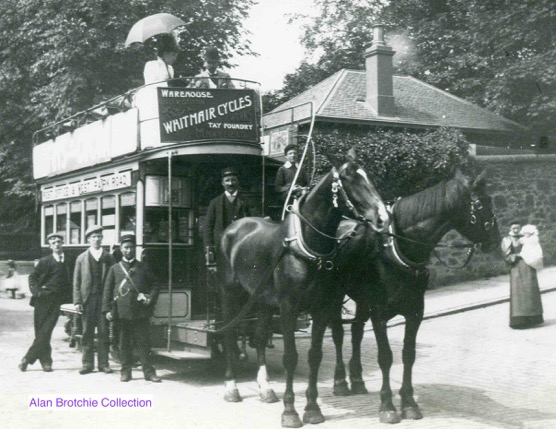
DCT Horsecar No 24 stands at the terminus at West Park Road — photo undated, but very probably taken in corporation days, i.e., after July 1899.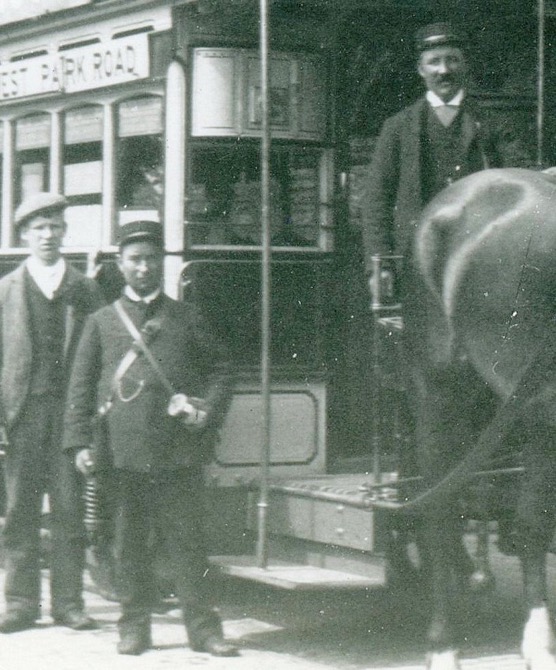
An enlargement of the above photograph showing the conductor and driver, both of whom appear to be wearing very similar uniforms to their company predecessors, without badges of any kind.
Steam tram drivers and conductors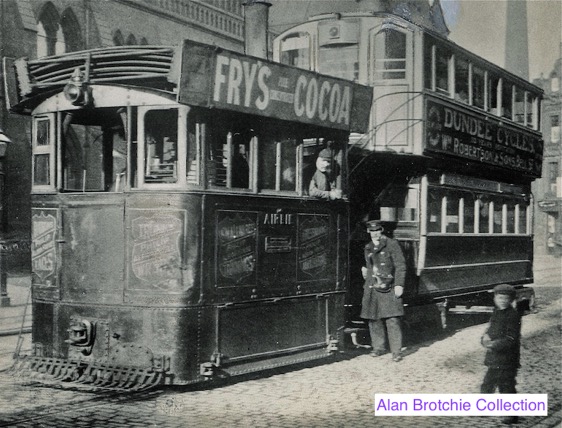
A driver and a conductor pose with Steam Tram No 4 — 'AIRLIE' — in Meadowside; photo undated, but definitely taken in the corporation era. The conductor may possibly be wearing a cap badge, though this is far from certain.
Motormen and conductors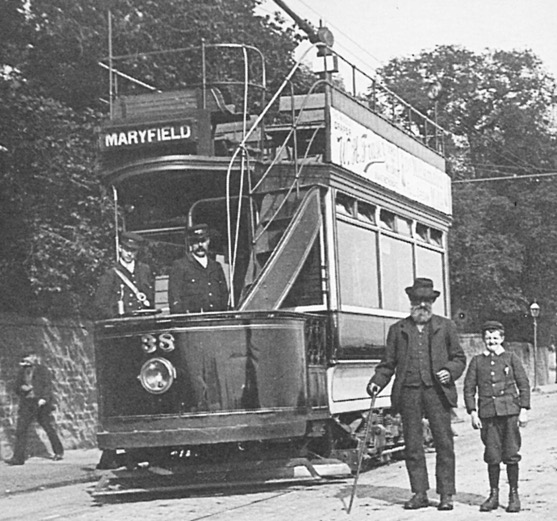
The crew of Tramcar No 38 pose for the cameraman with a service on the Maryfield line — photo undated, but probably taken in 1901. Both men appear to be wearing script-lettering grade badges on their caps. Photo courtesy of the Tramways and Light Railway Society, with thanks to David Voice.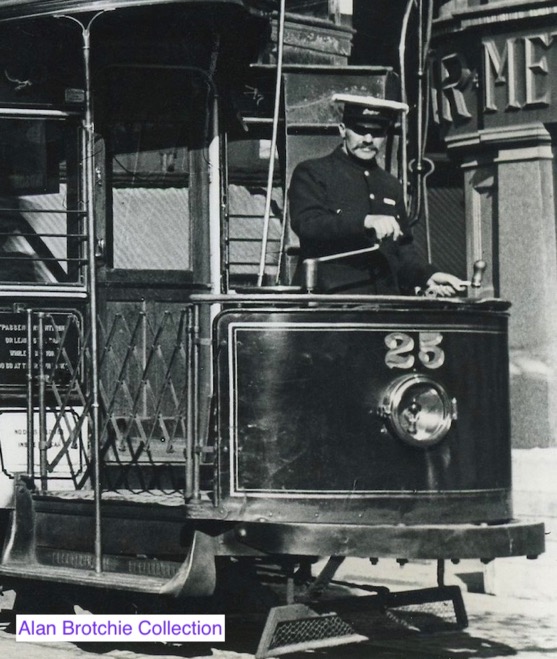
A motorman at the controls of Tramcar No 25 in Nethergate, at the top of Union Street — photo undated, but probably taken in 1905/6.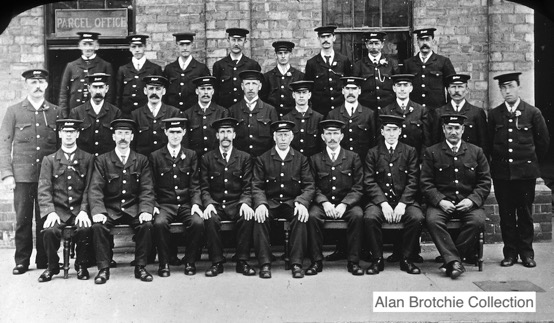
One of a series of staff photos taken at Maryfield Depot, this one outside the Parcels Office, probably in 1905 or 1906.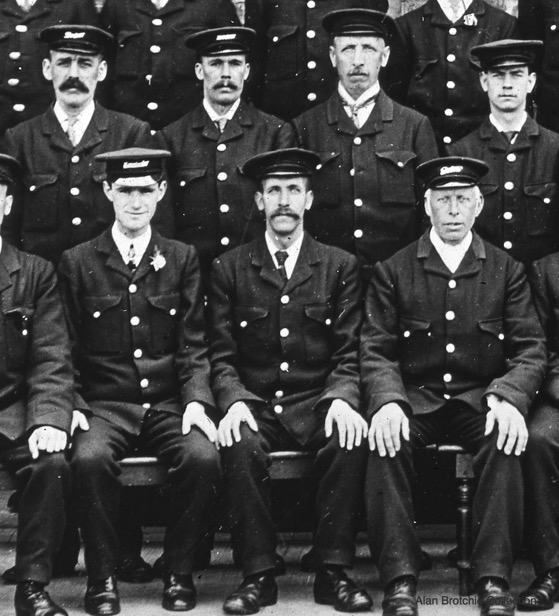
An enlargement of the above photograph showing details of the uniforms, which apart from the standard, off-the-shelf, script-lettering cap badges, 'Driver' and 'Conductor', are totally devoid of insignia. Even the cap badges are not being worn by half of those present.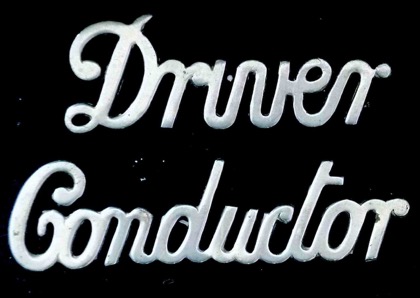
Script-lettering cap badges of the type worn by Dundee City Tramways staff from the start of electric services (in 1900) through to the time of the Great War — nickel. Author's Collection.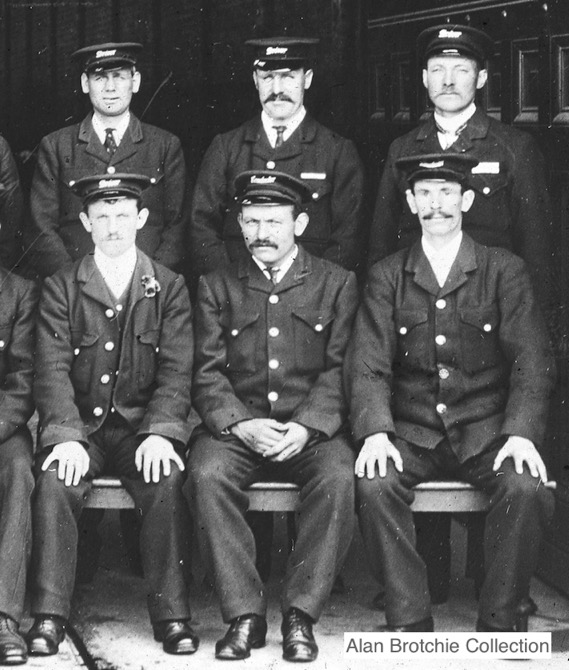
A group of six motormen and conductors pose for the camera in one of the car shed entrance doorways at Maryfield Depot, again probably in 1905 or 1906. Image cropped from a larger photograph.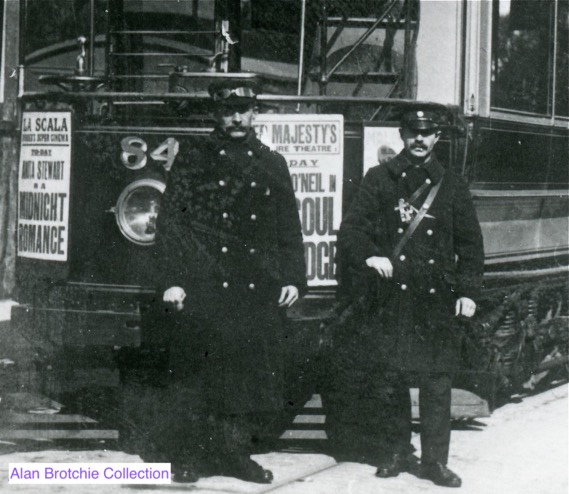
A motorman and a conductor with Tramcar No 84 at Downfield on either the 4th or 5th May 1920 (from the cinema ads). The motorman sports goggles, whilst the conductor has a small round cap badge of unknown pattern.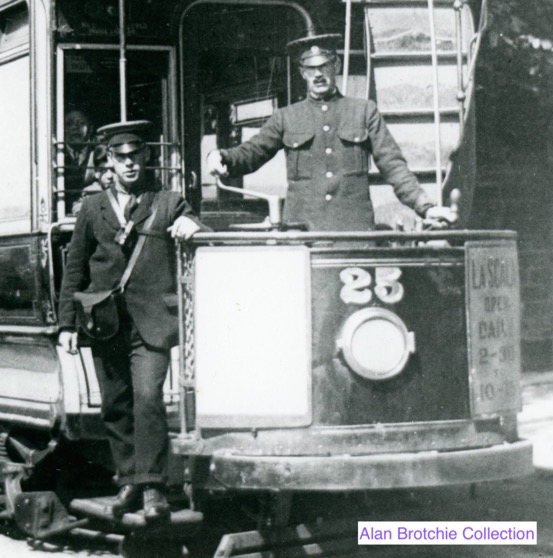
A conductor and a motorman with Tramcar No 25 at Ninewells — photo undated, but probably taken in the mid 1920s. Whilst the conductor is without a cap badge, the motorman is wearing the same, small round cap badge seen in other photos from the 1920s.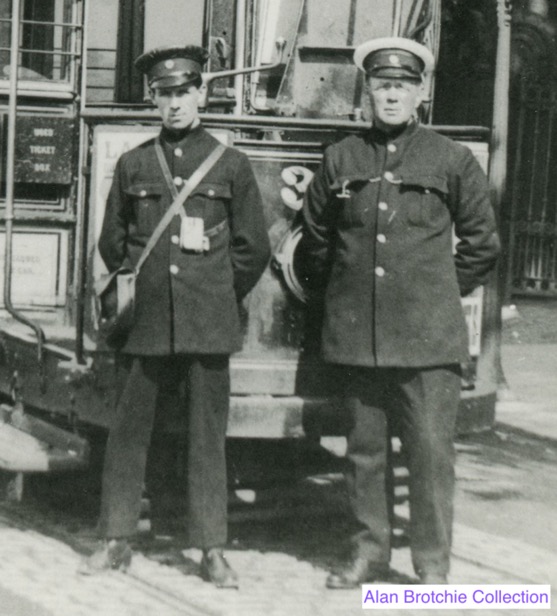
The crew of an unidentified tram on the Maryfield route — photo undated, but probably taken in the mid 1920s. Both men are wearing single-breasted tunics with the small round cap badge worn during this decade.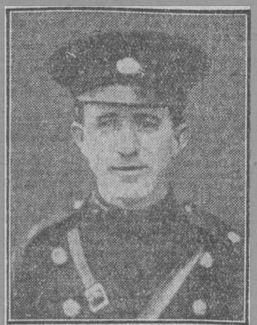
A photograph taken from an article in the Dundee Evening Telegraph marking the death (in a motorcycle accident in 1928) of Conductor Willie Clark, who was evidently a well-known figure. Although of poor quality, it clearly shows the size and shape of the cap badge that was worn at this time. Thanks to Alan Brotchie for alerting me to this.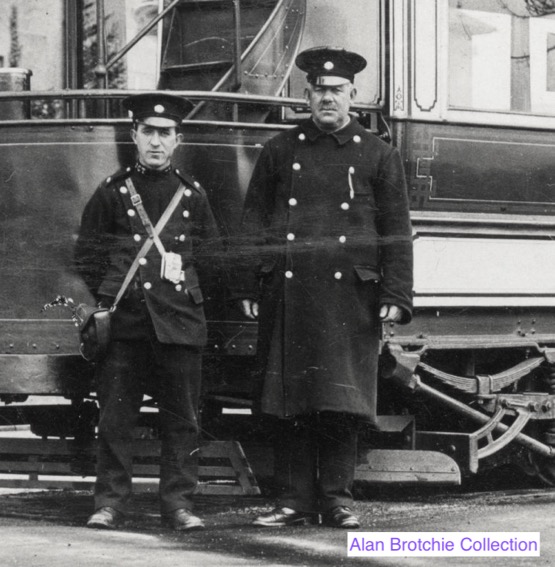
A conductor and a motorman pose in front of Tramcar No 44 at Blackness in the 1930s. Once again, both men are wearing a small round cap badge. The conductor is wearing a lancer-style tunic with stand-up collars bearing individual 'D C T' system initials (on his right-hand side).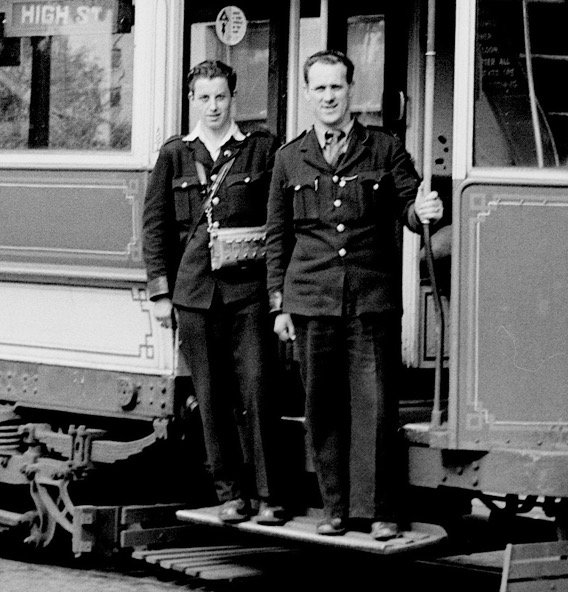
A conductor and a motorman on the footstep of Tramcar No 31 in Balgay Road on 4th September 1954. Photo by M J O'Connor, courtesy of the National Tramway Museum. 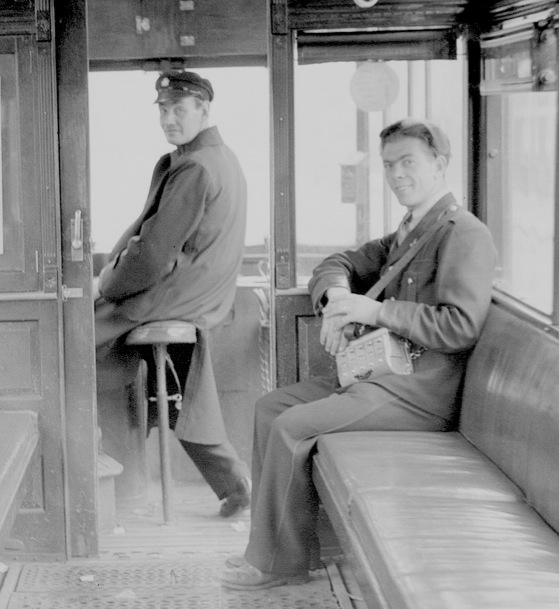
The motorman and the conductor of Tramcar No 8 pose for the camera of M J O'Connor who, thankfully for posterity, had a interest in interior shots like this one — photo taken on 6th September 1954 in Downfield. The shot clearly shows the soft-topped nature of the peaked caps that were worn in the last decade of operation, as well as the Dundee municipal-device cap badge. Photo courtesy of the National Tramway Museum. 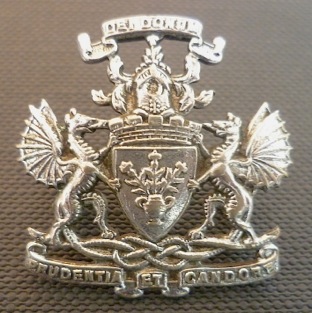
Dundee municipal-device badge — chrome. This pattern of badge was probably used on tramcar-crew caps from the 1930s onwards, but was certainly in use by the 1950s. It was almost certainly used by other corporation departments too. Author's Collection.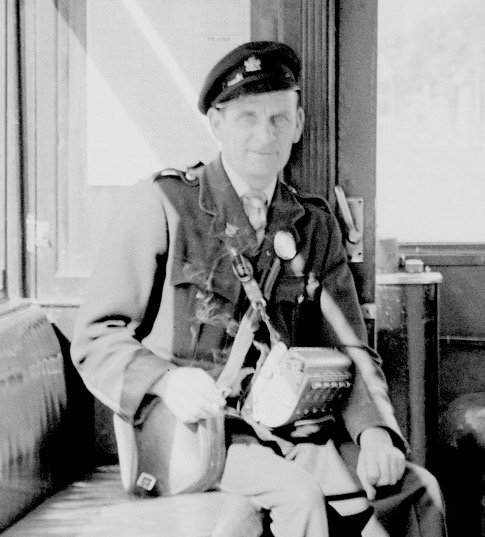
A DCT conductor poses for the camera in the interior of Tramcar No 16 on 18th August 1955. He is wearing a Scottish Sub-Area PSV badge on his left breast, indicating that he also worked on the buses. Photo by M J O'Connor, courtesy of the National Tramway Museum. 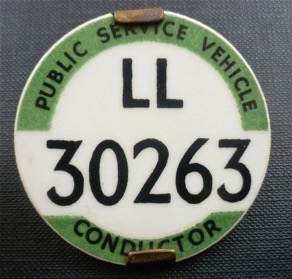
PSV ''CONDUCTOR' badge as used by Dundee Corporation Transport; issued by the Scottish Sub-area based in Aberdeen. Author's Collection.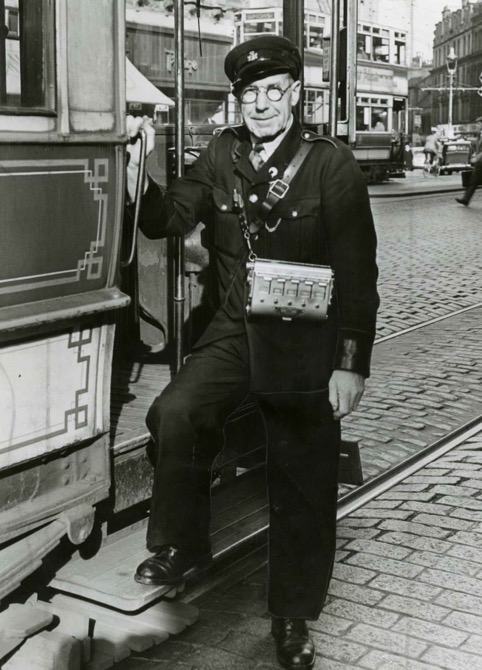
Conductor George Maxwell pictured on the 17th October 1956, three days before the last tram ran.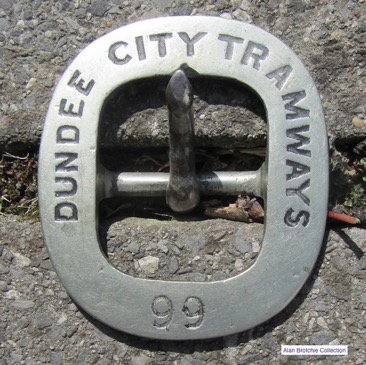
Dundee City Tramways ticket machine or cash bag buckle — nickel; the number was almost certainly that of the cash bag or ticket machine.
Senior staff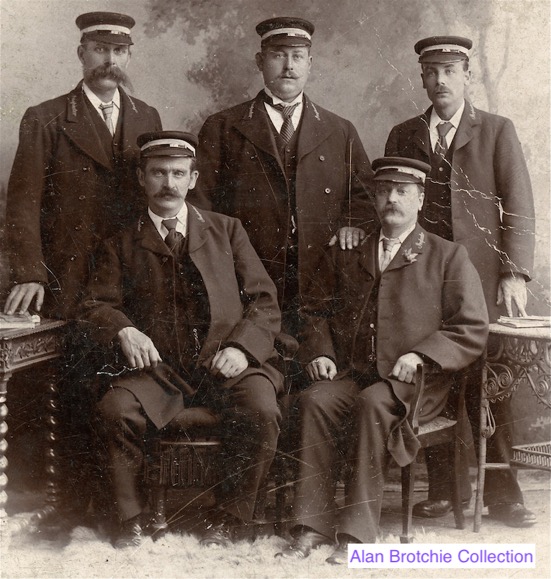
An evocative studio portrait of five Dundee City Tramways inspectors circa 1902.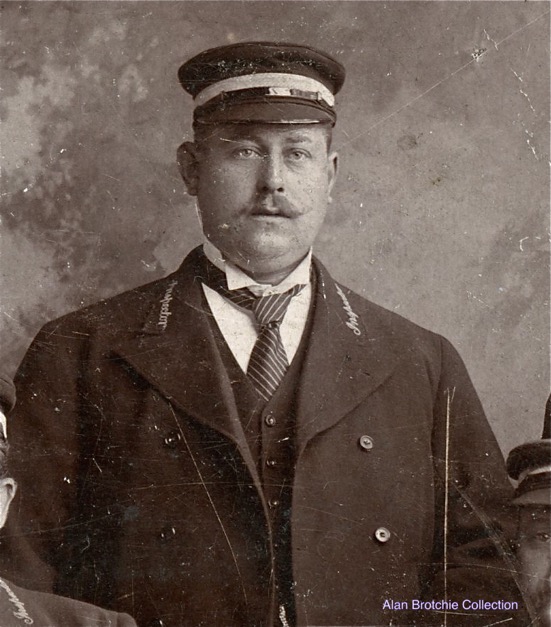
An enlargement of the above photograph showing James Fisher, brother of the General Manager Peter Fisher. The embroidered collar badges and plain buttons are clear to see, as is the complete absence of a cap badge.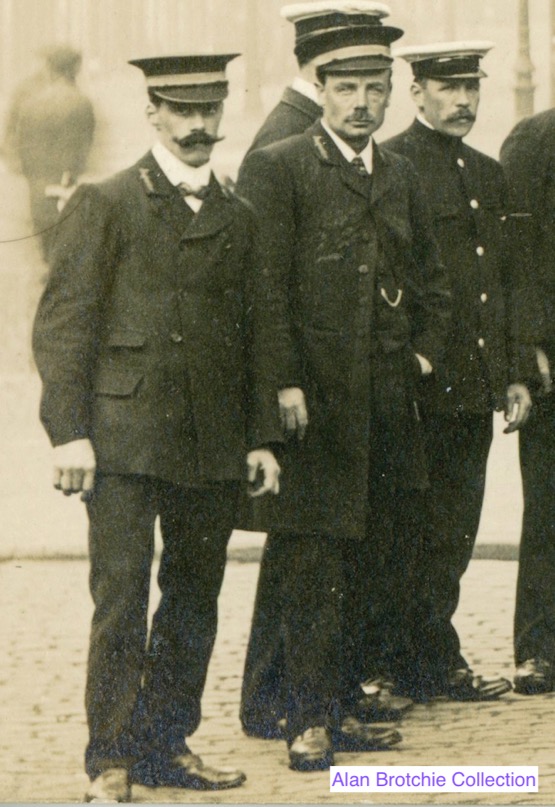
A couple of DCT inspectors, from a larger staff photograph taken circa 1906.
Female staff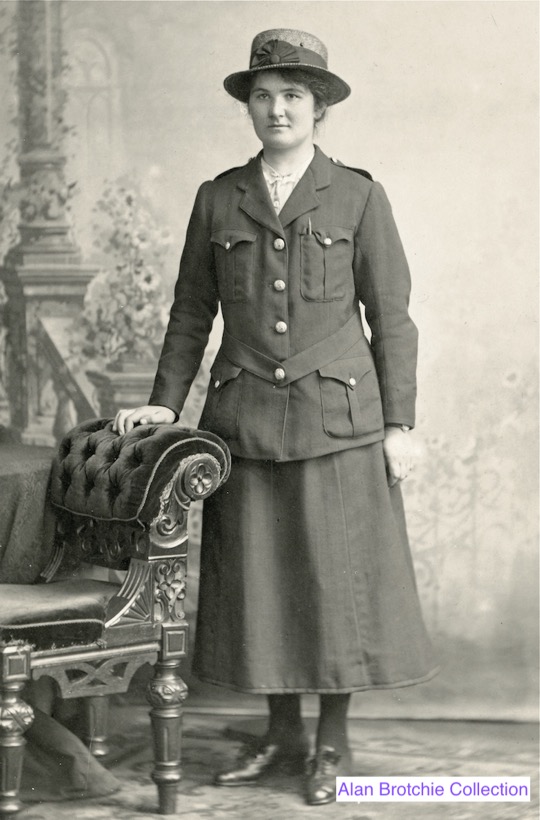
A Dundee City Tramways Great War conductress — photo undated, but certainly taken between 1917 and 1919. Although it is unclear whether the tall, cockaded straw bonnet is official headgear, the style is not as unusual as it may at first seem, several other tramways adopting similar headwear. 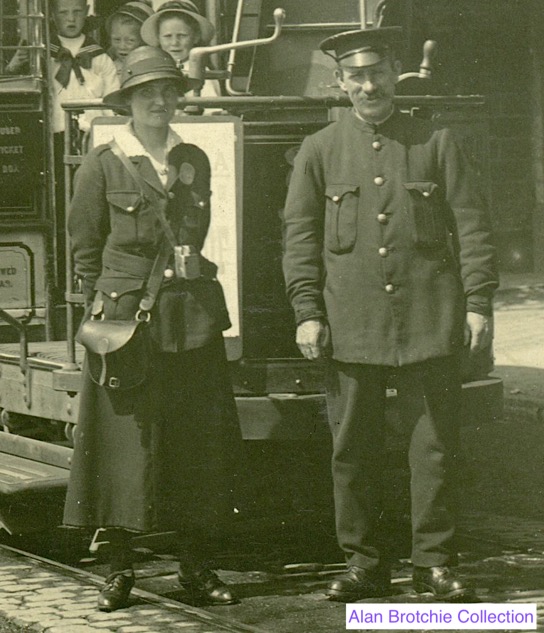
A Great War conductress and her motorman at Ninewells in 1918.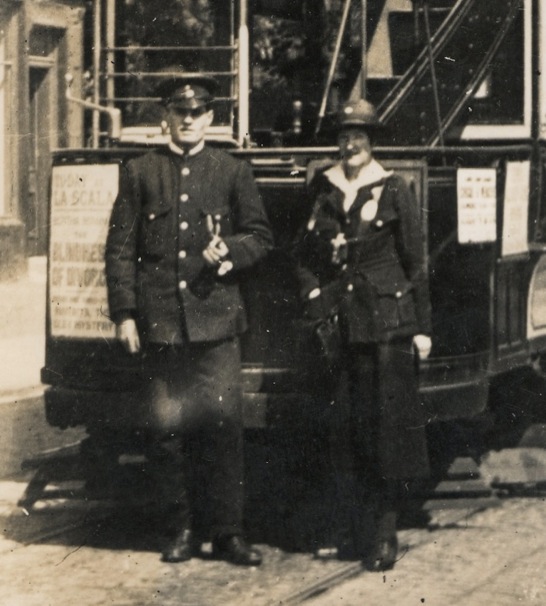
A Dundee City Tramways motorman and a conductress pose for the camera at the Monifieth terminus (on the DBF&DTCo system). The photograph can be precisely dated by the poster on the dash, which is for the 'Blindness of Divorce' at the La Scala, which on-line records reveal was showing on the 4th/5th/6th August 1919 (thanks to Alan Brotchie for this information). Both subjects are wearing the small unidentified round badges seen in other photos taken between the Great War and the 1930s. Author's Collection.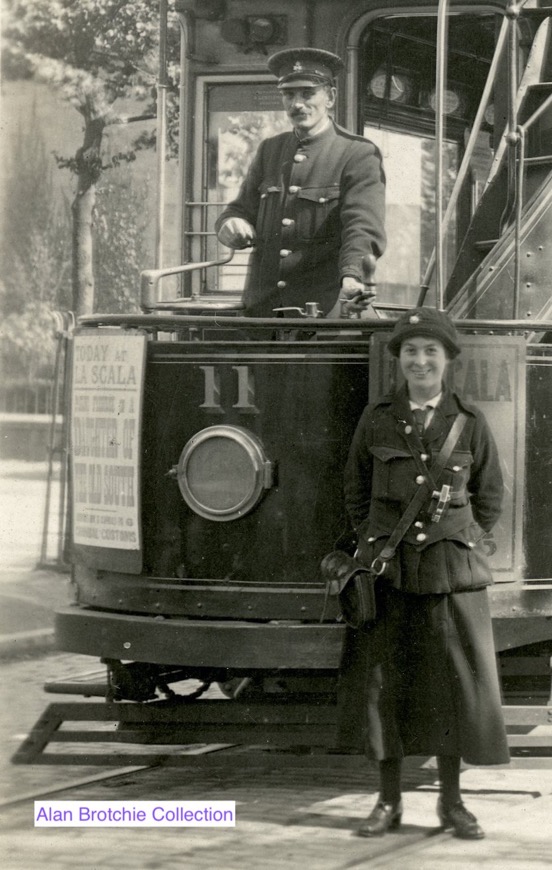
Another motorman and conductress photograph, this time of Tramcar No 11 at the Blackness terminus — although the photo is undated, the cinema advertisement is for the 18th-20th August 1919, so it would almost certainly have been taken during the week leading up to these dates. Both the motorman and the conductress are wearing cap badges — one round and the other with a cross and crown — the motorman's most probably regimental in origin.